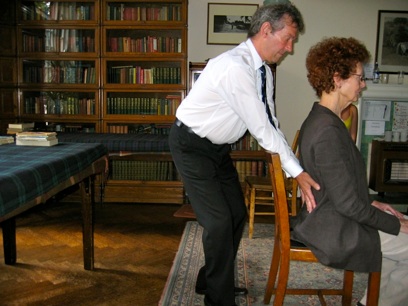In Memory of John Brown
Interview with John Brown, London June 2006
by Sabine Heubusch
For a long time, I had the desire to visit the Constructive Teaching Center (CTC) in London after learning about Walter Carrington in the teacher training course at the American Center for the Alexander Technique (ACAT). I visited the CTC for the first time in the summer of 1998, and immediately loved London’s aristocratic flair, its parks and architecture, the history of Punk, and electronic music culture. I visited several times between 1998 and 2006 on my way from Austria to the US when I had the fortune of meeting Walter Carrington, and I was able to take some lessons with him. I vividly recall his gentleness of his touch and personality, and I felt welcome and comfortable right away in the school.

At the end of my visit in 2006, I asked John if I may interview him, and he agreed without hesitation. Now, here we are in 2009, and I did not publicize this interview in time so John could see it. I do believe that John’s spirit is alive, and I will continue to appreciate his profoundness and dedication to the work. Thank you John.
Q: When was the CTC founded?
A: In 1960
Q: Where did the name for the school come?
A: Walter said once: “I had to call it something.”
Q: What is the philosophy of the school and the overall theme?
A: Be as true as possible to the principles of the Alexander Technique (AT) the way they are outlined in Alexander’s books. [The school provides] a touchstone for what Alexander discovered. We don’t want the essence to get lost.
Q: The CTC seems to be a very safe place as a learning environment. There is a sense of freedom and peace and also a good amount of laughter in the training course. Is that something that has been cultivated consciously?
A: Walter’s personality had a big effect on how the place has evolved. Walter was the head of the CTC, but never came over like that, and allowed people to be themselves.
Teaching is not something that tells what to do, [teaching is] to have respect for the individual and allows people to be themselves.
Q: How did Walter’s death affect the school and how did you manage to keep the school going?
A: Gradually over the years I started to take over and taking on more responsibility. Walter was missed, but after he passed, we went on teaching. It’s always been an organized and developing place. Walter left everything organized.
Q: What did you learn from Walter?
A: Be responsible for myself.
Q: How did you get involved with the CTC?
A: I was trained in Denmark and after the school closed prematurely I finished my training here. I started to work as a Secretary for Walter.
Q: What is the message you want to give to the students?
A: Time-taking time, self-responsibility of the student.
Learn it for yourself; don’t copy teachers (which was also FM’s and Walter’s message). It is an art, what’s the point of imitating great art. Be your own artist.
Q: Was the structure of the curriculum developed by Walter, or was it more based on FM’s Training course?
A: It was Walter’s development. Making sure that no student got neglected or left out. Groups of three rotating game is [also] a Walter development: walking, creeping, hand on back of the chair, raising an arm, looking at ceiling…letting it develop from freedom and ease.
[Other subjects of the curriculum]: Activities carried out with mechanical advantage, breaking things down to the basic elements in games, Jerry Foley’s talks (engineering), anatomy, voice, reading, games, groups, giving turns.
Q: What do you envision for the future for the CTC and for yourself?
A: As long as people want to come and train with us, we continue in the same tradition.
Sabine Heubusch is originally from Austria. She lives and works in New York and is an AmSAT certified practitioner of the Alexander Technique. Sabine also teaches Dalcroze Eurhythmics, Yoga, Pilates and Dance Free Style to children. She is a dancer and performer, and is passionate about traveling and learning about different cultures

